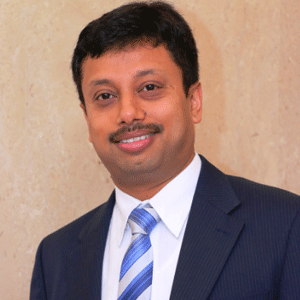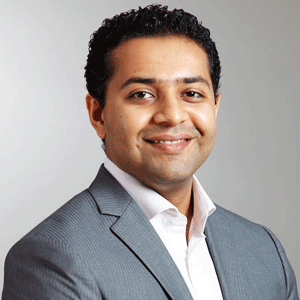THANK YOU FOR SUBSCRIBING

Digital Disruption - Accelerating Product Innovation and Distribution in Mutual Fund
Kaushik Chakraborty, SVP & Head – Digital Marketing & Alternate Channels, UTI Mutual Fund


Kaushik Chakraborty, SVP & Head – Digital Marketing & Alternate Channels, UTI Mutual Fund
The story of the mutual fund industry in India started in 1963 with the formation of Unit Trust of India (UTI) at the initiative of the Reserve Bank of India (RBI) and the Government of India. The objective then was to attract small investors and introduce them to market investments. Over the years, UTI’s growth shaped the contours of the mutual fund (MF) industry itself. The year 2003 was a landmark year for the industry, when UTI was bifurcated into two — one of which was the UTI Mutual Fund — which even today, is one of the largest players in the field, much like what the erstwhile UTI used to be.
How big is the "Digital Economy?"
Digital is a way of life. Today the world has estimated 7.52 billion mobile connections, 3.17 billion internet users and 1.79 billion social media users. What this means is that there are more mobile phone connections in the world than human (approx 7 bn), close to 2.5 out of 5 humans are already online and 1 out 4 human is using social media. This connected online population forms a brand new market that cuts across borders - a market in which the power of choice, information access, convenience and a feeling of community are taken for granted.
The Four Mega Trends
- The world is going mobile
- Micro Transactions
- Humans are the new social animal
- Big Data leverage
The world is going mobile - Mobility ensures that customers have portable multimedia devices with Internet access and empowers them with the ability to make instant decisions anywhere and anytime. There already is and there will be an even more rapid shift in terms of the number of people having access to the internet over phones. Mobile tech is the best fit for the digital economy as these bypasses the constraints of deficient physical infrastructure and is always "on".
Micro Transactions are the new norm. Falling tech costs have radically lowered breakeven requirements in terms of transaction size. Thus all sizes of transactions have gone online enabling wider range of products and services through the internet. In India more than 50 percent mobile top-ups are "Chhota Recharge" (< $1). In banking, Internet and Mobile Banking transactions costs less than 1/200th of a physical branch transaction.
Humans are the new social animal. Social media satisfies a variety of human psychological needs, almost in line with Maslow's hierarchy beyond safety and physiological needs. It provides for belonging, self-esteem and self actualisation. Some startling facts on Social Media
- There are nearly 1.4 billion Facebook users
- 47percent of all Internet users are on Facebook
- 88percent of Twitter users are on mobile
- There are 500 million tweets per day
- 70 million photos and videos are sent daily on Instagram
- 88percent users purchase a product they pinned on Pinterest
- Out of the 350 million LinkedIn users about 40 million are students and recent college grads
- Social networks earned approx $8.5 billion from advertising in 2015
Big Data Leverage
Big Data tech is making it increasingly easy to acquire granular level data. Granularity allows micro-segmentation, customisation of offers, customised pricing and diversification of risk. Few enablers for making this possible are
- Lower data storage costs
- Increased data processing capability
- Enhanced ability to integrate company and public data
- Improved capabilities to bring together various sources of data to identify patterns and create stories than can be commercially useful
Digital in India is no different
India is no different and it already has the 2nd largest digital population of the world
- 900 million mobile connections (Globally #2)
India is exponentially better in mobile adoption than the rest of the world. Out of the 300 million internet users, 200 million (65percent) users are mobile only internet users.
In fact, Digital Influence in India is 2.5 times the actual digital sales that happen. Following are few interesting data points
- 28percent of all buyers across categories are internet users
- 15percent of all buyers engage in at least one of the stages in pre-purchase, purchase or post-purchase activities online
- 6percent of all buyers indulge in actual digital sales
So firstly Digital is not only about digital buying. It is mainly about the influence that the brand has over its potential customers through digital means.
Digital in India is disruptive
Five disruptive themes challenging business models today are
- Physical footprint is less relevant today - The modern consumer values convenience and value for money over everything else including brick and mortar stores / offices.
- Big Data and analytics break entry barriers - The relatively lower cost of leveraging digital tech compared to physical presence, combined by customer acceptance of new products and brands, is breaking down the barriers to entry across industries. Data Analytics is helping organisations create CX (customer experience) as a competitive advantage.
- Brand Partnerships and digital cross-selling at the point of customer intent
- New convenience platforms making company interactions more social resulting in new product ideas, better customer services and improving social influence
- Mobile internet driving customer engagement and sales
The new breed of Investors
As a result of impressive growth in technology, a new breed of investors - more informed and more inquisitive is emerging in our country. Never before an Indian investors had so much available to them at the click of a button or tap of a phone. The Internet has emerged to be a powerful tool for people to manage their money and get financial news. As a result, there has been a boom in online searches, online brokerage firms and financial news web sites.
Today, many individual investors make extensive use of Internet for investment research and their number is increasing day by day. By visiting various web sites, they can now see fund’s portfolio, scan corporate results and research reports, get stock quotes, and engage in e-trading. The new era for technological revolution has brought with it longer trading hours, lower costs, and greater transparency and better pricing information.
Further, emergence of online brokerage firms has given many investors ease of use and lower commissions than charged by traditional brokerage houses. As traditional ways of doing business have been transformed by technology, many high net worth individuals are opting for online investing. Far from being passive spectators, these new investors are proactive, are directly involved in making their own investment decisions, managing their assets, and researching investments.
Technology in the mutual fund industry
Effective and on-going communications with unit-holders heightens importance for the mutual fund industry. Mutual funds are attractive savings vehicles for investors, often investing for the long-term future such as retirement plans, higher education, etc. Therefore, the need to communicate and service millions of investors, who frequently purchase units on an on-going basis (for instance systematic investment plans), makes it vital for the mutual fund industry to invest in technology. Technology has made the explosive growth of the industry manageable.
The relentless pace of technological change and user needs are all changing the way we use, or even understand innovations, such as the internet or mobile. Technology through internet and mobile
- Reduces distribution and transaction costs
- Speeds up document processing online
- Provide instantaneous access to information
- Enable investment decisions
- Handle investor’s grievances and many more things
- This in turn dramatically improves efficiency and decrease the costs of back office
- The Internet lets mutual funds engage in "one-to-one marketing" allowing them to tailor the online experience to fit unique individual needs.
Technology and the impact on distribution of mutual fund products
The area that is most likely to have the biggest impact as result of changing technology is MF distribution. Even though average investment in technology in this sector is yet not very high, distribution of mutual fund products and services is likely to be immensely affected by technology in a big way. Financial products such as mutual funds are being sold differently. More funds will sell and service their products through the Internet, Mobile, ATMs, kiosks, etc. While several mutual funds like UTI Mutual Fund have already started offering investments on the net, mobile and other alternate channels like Call centres, many Registrar and Transfer Agents (RTAs) too have invested heavily in technology.
Figuring out the best way to distribute products and services is the challenge mentioned most often by the mutual fund industry. The three biggest challenges facing the insurance industry are distribution, distribution and distribution. Fund houses are now experimenting with several methods of delivery. No one is likely to rely any longer on a single form of distribution. Funds are now selling their products through agents, the Internet, the mobile, the Stock Exchanges and through other third parties. Each fund has to be able to provide products and services across distribution lines to stay competitive in the overall marketplace.












